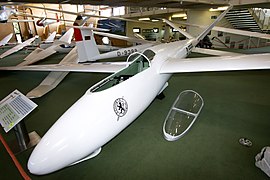HKS (aircraft)
| HKS | |
|---|---|

|
|
| Type: | Glider |
| Design country: | |
| Manufacturer: | |
| First flight: |
1955 |
HKS is a single seat glider .
HKS 1
The Haase - Kensche- Schmetz constructors' association developed the two-seater performance sailor HKS 1 in 1952 as the forerunner of the HKS 3 . The HKS 1 D-5300 was flown in from Haase on July 19, 1953 in Düsseldorf. The version HKS 1 V1 D-5300 broke on the return transport at the 1958 gliding championships in Leszno (Poland). In 1954 the state of North Rhine-Westphalia sponsored the construction of a second machine, the HKS 1 V2 D-5555. The machine was rebuilt several times and used for wave and measurement flights, also by the Akaflieg Braunschweig . Due to the increase in weight as a result of various conversions and revisions, the D-5555 was only allowed to be flown in a single seat from 1966. On January 22nd, 1973 the LBA deleted the HKS 1 from the list of approved gliders. In 1978 the North Rhine-Westphalia regional association of the German Aeroclub donated the HKS to the German Gliding Museum on the Wasserkuppe.
The HKS was stored in a shed until autumn 2007, until the workshop team at the Gliding Museum brought the “dinosaur” into the workshop of the newly built extension in October. Large areas of the casein- glued construction were replaced and the parts destroyed by water ingress were rebuilt. The project HKS 1 V2, D-5555 - dismantled to the original two-seater version - was completed at the end of April 2009. The HKS can be viewed in the large exhibition hall of the German Gliding Museum on the Wasserkuppe.
HKS 3

Together with Kensche and Schmetz, Haase was the designer of the record and world champion glider from 1958. A special feature was the elastic profile curvature of the rear wing part for transverse control and change of lift, perfecting the wooden construction for gliders that was customary at the time. The wing skin consisted of two layers of plywood with a layer of foam in between. The spar belts were made of light metal, the aircraft had a V-tail unit and a braking parachute . Repeated filling and grinding resulted in a very high profile accuracy, which was immediately noticeable in the flight performance. The HKS 3 proved to be an indispensable link to the first plastic aircraft fs 24 Phoenix with laminar profile and its successor Phoebus
Technical specifications
| Parameter | Data |
|---|---|
| crew | 1/2 |
| Hull length | 7.16 m |
| span | 17.2 m |
| height | |
| Wing area | |
| Wing profile | NACA 64-012 |
| Max. Takeoff mass | 410 kg |
| Water ballast | 75 kg |
literature
- Heinz Kensche: The development of the HKS 1 glider , magazine for flight sciences, 2nd year, issue 1, January 1954
